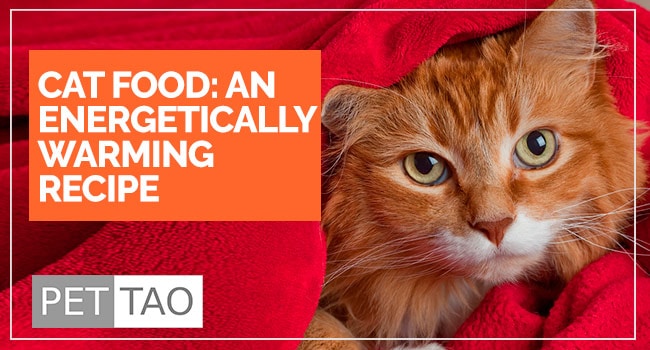Has your cat become thin and weak?
Has he stopped playing the way he used to?
Is he sluggish osr depressed?
If you answered yes to the above questions, your cat may be Qi deficient and need a warming cat food recipe.
Qi Deficient Cats Need a Warming Diet
Qi deficient cats are usually older.
However, in certain breeds, even young cats may be Qi deficient.
Qi deficient cats appear lazy, lack energy, and snuggle up in warm places.
Often, Qi deficient cats are overweight and depressed.
If your cat has these characteristics, the warming cat food recipe is what you need!
The classic signs of Qi deficiency in cats are:
- Pale, swollen tongue
- Drooling
- Shortness of breath
- Seeking warm places
- Fatigue
- Loss of appetite
- Loose stools
- Wiry pulse
- Depression
- Frequent urination
- Slow metabolism
What is Qi Deficiency in a Cat?
In TCVM, Qi is the energy of the body.
Qi is the energy of the meridians within the body, the energy of food, and the energy of the universe.
Qi deficiency is a state in which the body lacks Qi.
Energetically Warming Foods
Use Eastern Food Therapy to warm a cool cat.
Treat cat Qi deficiency by feeding an energetically warming cat food.
A nutritionally balanced feline diet contains:
- 75% – 90% Protein – from meat
- 10% – 25% Carbohydrates – from grains, vegetables, and fruit
- A minimum of 2% fat
Use the list of foods below to create endless delicious recipe combinations for your furry friend!
Mix up the ingredients as needed to create a food that your cat loves.
You can easily track the protein, carbohydrate and fat ratios in an online food log like the ones found on Fitbit and Livestrong websites.
You also need to add a taurine supplement to each batch of cat food you make.
For cats, taurine is an essential amino acid.
Taurine is critical for normal digestion, heart muscle function, normal vision, and to maintain a healthy immune system.
Energetically Warming Food List
It’s best to use all warming foods, but you can use one neutral ingredient per batch for convenience.
Meats/Protein Source
Chicken
Venison
Shrimp, lobster
Ham
Sunflower seeds
Pork, pork liver & kidney (neutral)
Beef, beef liver (neutral)
Fish, salmon, sardines, tuna, catfish, carp, mackerel (neutral)
Goose (neutral)
Pigeon (neutral)
Chicken eggs (neutral)
Wild rabbit (neutral)
Quail (neutral)
Vegetables/Fruits
Sweet potato
Pepper
Pumpkin
Tangerine
Sweet pepper
String beans (neutral)
Green beans (neutral)
Green peas (neutral)
Beets (neutral)
Cabbage (neutral)
Apple (neutral)
Carrots (neutral)
Cauliflower (neutral)
Asparagus (neutral)
Grains/Beans/Starch
Oats
Quinoa
Corn (neutral)
White rice (neutral)
Beans, soy, black, broad, kidney, red (neutral)
Peanuts (neutral)
Potato (neutral)
Fats
Olive oil
Flaxseed oil
Soya oil
Peanut oil (neutral)
Black sesame oil (neutral)
Energetically Warming Cat Food Recipe
3 pounds meat and dairy (see “meat/protein source” section above)
1/3 pound vegetables and fruits (see “vegetable” list above)
1/2 tablespoon of olive oil or flaxseed oil
1/4 pound sweet potatoes (or grains and beans, cooked weight)
1/4 pound white rice (or grains and beans, cooked weight)
Optional: 1/2 teaspoon basil, 1/2 teaspoon clove
Directions:
Debone and chop meat and vegetables.
Place all ingredients in crockpot layering:
- Slow cooking root vegetables on bottom
- Meat in the middle
- Fast cooking items on top
Top with 1 cup water.
Cook on low for 4 hours.
In addition, add the following to your pet’s diet:
- One cat multivitamin dose per day
- Calcium supplement 50mg/kg of body weight (22mg/lb of body weight) per day. Some other good choices for calcium are eggshell powder or bone meal.
- Taurine between 250mg and 500mg per cat per day
Feeding Schedule
Feed roughly 1/2 cup per 10 pounds of body weight twice daily.
Make sure to give your cat a feline multivitamin while on the plan.
Monitor your cat’s weight. If an undesirable weight loss occurs, please contact your veterinarian immediately so you can make an adjustment in your cat’s feeding/diet plan.
If your cat is picky, you may want to run the food through the blender prior to feeding.
When cooked this way, the vegetable pulp mixes with cooked meat juices to create a nutritious broth.
Often, cats will lap up the broth more readily than eat small vegetable chunks.
As you can see, cooking for your cat isn’t really difficult, and can be a rewarding experience for both you and your cat!
Please consult with your veterinarian and use personal judgment when cooking at home for your cat.
Even though pet food recalls and the poor quality of some pet foods are a concern, many veterinarians voice concerns over homemade diets.
Some vets feel that when fed exclusively, homemade diets may result in vitamin/mineral deficiencies that can adversely affect a pet’s health.
If you choose to feed your cat a homemade diet, you must understand and meet your cat’s needs to stay healthy.
Please share our recipe with your veterinarian. Your veterinarian can advise you on supplements for your pet’s individual situation.
Monitor your cat’s health by observing his/her temperament, skin, coat and waste. If you notice anything strange, contact your veterinarian immediately.








